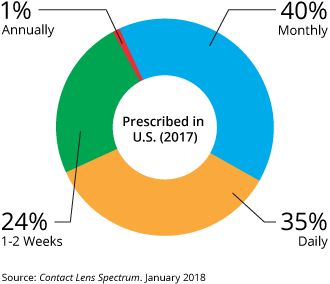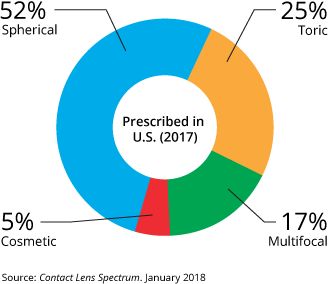Guide
When To Replace Your Contact Lenses
Even with proper care, contact lenses (especially soft contacts) should be replaced frequently to prevent the build-up of lens deposits and contamination that increase the risk of eye infections.
Soft lenses have these general classifications, based on how frequently they should be discarded:

Lens Replacement Frequency
-
Daily disposable lenses — Discard after a single day of wear
-
Disposable lenses — Discard every two weeks, or sooner
-
Frequent replacement lenses — Discard monthly or quarterly
-
Traditional (reusable) lenses — Discard every six months or longer
Gas permeable contact lenses are more resistant to lens deposits and don't need to be discarded as frequently as soft lenses. Often, GP lenses can last a year or longer before they need to be replaced.
The most frequently prescribed contact lens replacement schedule in the U.S. in 2017 was monthly (40 percent), followed by daily (35 percent), every one to two weeks (24 percent) and annually (1 percent).
Contact Lens Designs
Soft contact lenses (both standard hydrogel and silicone hydrogel lenses) are available in a variety of designs, depending on their intended purpose:

Soft contact lens designs
-
Spherical contact lenses have the same lens power throughout the entire optical part of the lens to correct myopia (nearsightedness) or hyperopia (farsightedness).
-
Toric soft contact lenses have different powers in different meridians of the lens to correct astigmatism as well as nearsightedness or farsightedness. [Read more about toric contact lenses.]
-
Multifocal contact lenses (including bifocal contacts) contain different power zones for near and far vision to correct presbyopia as well as nearsightedness or farsightedness. Some multifocal lenses also can correct astigmatism. [Read more about bifocal contacts.]
-
Cosmetic contact lenses include color contacts designed to change or intensify your eye color. Halloween, theatrical and other special-effect contacts also are considered cosmetic lenses. A contact lens prescription is required for cosmetic contacts even if you have no refractive errors that need correction.
All of these lenses can be custom made for hard-to-fit eyes. Other lens designs also are available — including lenses fabricated for use in special situations, such as correcting for keratoconus.
More Contact Lens Features
Bifocal contacts for astigmatism. These are advanced soft contacts that correct both presbyopia and astigmatism, so you can remain glasses-free after age 40 even if you have astigmatism. [More about bifocal contact lenses for astigmatism.]
Contacts for dry eyes. Are your contacts uncomfortably dry? Certain soft contact lenses are specially made to reduce the risk of contact lens-related dry eye symptoms. [More about contact lenses for dry eyes.]
Colored lenses. Many of the types of lenses described above also come in colors that can enhance the natural color of your eyes — that is, make your green eyes even greener, for example. Other colored lenses can totally change the color of your eyes, as in from brown to blue.
Special-effect lenses. Also called theatrical, novelty, or costume lenses, special-effect contacts take coloration one step further to make you look like a cat, a vampire, or another alter-ego of your choice.
Prosthetic lenses. Colored contact lenses also can be used for more medically oriented purposes. Opaque soft lenses called prosthetic contacts can be custom-designed for an eye that has been disfigured by injury or disease to mask the disfigurement and match the appearance of the other, unaffected eye.
Custom lenses. If conventional contact lenses don't seem to work for you, you might be a candidate for custom contact lenses that are made-to-order for your individual eye shape and visual needs.
UV-inhibiting lenses. Some soft contact lenses help protect your eyes from the sun's ultraviolet rays that can cause cataracts and other eye problems. But because contacts don't cover your entire eye, you still should wear UV-blocking sunglasses outdoors for the best protection from the sun.
Scleral lenses. Large-diameter gas permeable lenses called scleral contacts are specially designed to treat keratoconus and other corneal irregularities, as well as presbyopia.
Myopia control contacts. Special contact lenses are being developed to slow or stop the progression of nearsightedness in children. [More about myopia control.]
Which Contact Lens Is Right for You?
First, your contacts must address the problem that is prompting you to wear lenses in the first place. Your contact lenses must provide good vision by correcting your myopia, hyperopia, astigmatism, or some combination of those vision problems.
Second, the lens must fit your eye. To do that, lenses come in tens of thousands of combinations of diameter and curvature. Of course, not every lens brand comes in every "size."
Your ECP is skilled in evaluating your eye's physiology, and your eyesight, to determine which lens best satisfies the two criteria above.
Third, you may have another medical need that drives the choice of lens. For example, your ECP might pick a particular lens if your eyes tend to be dry.
Finally, consider your "wish list" of contact lens features — colors, for example, or overnight wear.
When you and your ECP decide on the right lens for you, you'll be given a contact lens prescription. You'll be able to buy a supply of lenses from your ECP or from the many other outlets that sell contact lenses. [For more on this, please read "Where's the Best Place to Buy Contact Lenses?"]
Contact Lens Wear and Care
Caring for your contact lenses — cleaning, disinfecting and storing them — is much easier than it used to be.
A few years ago, you would have needed several bottles of cleaning products, and perhaps enzyme tablets, for proper care. Today, most people can use "multipurpose" solutions — meaning that one product both cleans and disinfects, and is used for storage.
People who are sensitive to the preservatives in multipurpose solutions might need preservative-free systems, such as those containing hydrogen peroxide. These do an excellent job of cleaning contacts, but it's very important to follow the directions for using them. The solution should not come into contact with your eyes until soaking is complete and the solution is neutralized.
Of course, you can avoid lens care altogether by wearing daily disposable contact lenses.
Contact Lens Problems
Trial and error often is involved in finding the perfect lens for you. People react differently to various lens materials and cleaning solutions.
Also, the correct "parameters" of your lens — that is, power, diameter, and curvature — can be finalized only after you've successfully worn the lens. This is especially true for more complex fits involving extra parameters, such as with bifocals or toric contact lenses for astigmatism.
If you experience discomfort or poor vision when wearing contact lenses, chances are that an adjustment or change of lens can help.
Today, more contact lens choices than ever are available to provide comfort, good vision, and healthy eyes. If your eyes or lenses are uncomfortable or you are not seeing well, remove your lenses and visit your eye care professional to explore available remedies for contact lens discomfort.



